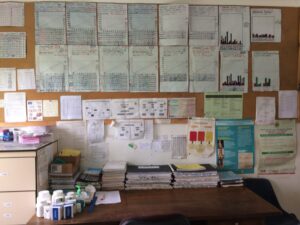Blame it on the System
The following is a re-post from a blog written by Dr. Elvira Beracochea on August 26th
The problem is not Ebola – the problem is the health system in the affected countries that is not able to detect an epidemic and trigger immediate control measures effectively in spite of the fact that the knowledge and technology to do so exists.
Epidemics of any infectious disease, be it Ebola, pneumonia, measles or meningitis, or non-communicable disease such as heart disease and pregnancy-related conditions that kill a lot more people than Ebola require a programmed response of a country’s health system. Ebola or Marburg or any scary and deadly outbreak is a symptom of weak health systems that need to be strengthened. As a global health expert, I know what needs to be done and how, and I am not the only one. There are many professionals that know how design and implement health surveillance and disease control programs. It is time we work together to realize a global health system that uses www.healthmap.org and helps every country’s health system to become self-reliant and sustainable in its capacity to meet the needs of its people as well as share information across countries for pandemic response when necessary.
Health systems are a three level pyramid. They need an effective governance level at the top that among other things creates effective policies, plans annual activities through its health programs, budgets for them, coordinates the implementation of public health programs and private healthcare delivery service providers and most importantly has an effective “Health Surveillance System (HSS)” to keep track of important diseases that affect the country’s population and to detect any “unusual” diagnosis. Without an HSS, a country is “blind” and cannot effectively plan and manage programs to keep their people healthy. An effective HSS must detect the first “suspicious” case of Ebola (or any disease that requires immediate or continuous preventive and control actions). The HSS informs and triggers the deployment of the team that confirms the diagnosis of the disease in question and leads the implementation of the required infection control and prevention program (ICP). This ICP is implemented by the trained, well-supplied (from protective clothing and tools and diagnostic equipment to medicines and bed linen) and ready professionals at primary and secondary facilities (the other two levels of the health system pyramid) and through public health information and education programs. This is not rocket science anymore. We know how HSS and ICPs must work.
We, global health professionals, know what to do to implement an HSS and ICPs, but do not seem to be able to get it done at scale in the countries that need it. We know that is how an HSS alerts the health system and how an ICP allows health professionals to implement and coordinate effective programmed responses throughout the health system to reach the vulnerable or those at risk, treat the sick and prevent the spread of the disease. This happens every day in most developed countries. However, in many African countries, health systems have many weaknesses. They either have no HSS or it is so weak that the press will usually alert the public of an epidemic before the country’s health system has had any time to react. There are no or rudimentary ICPs or written operations manuals to train medical staff about what to do to prevent spread and control an epidemic. Health facilities are usually unable to meet the needs of the usual demand for health services and are unprepared to respond to the increased patient load of epidemics of any kind that unfortunately happen regularly.
The thing is that the problem is not the Ebola epidemic. The problem is the health system that needs to be strengthened to respond to the health needs of the population it is supposed to serve. How long are we going to keep swatting the flies and once and for all repair the holes in the screen door? The Ebola outbreak, although deadly and scary and even a bit sensationalistic, is just a symptom of a larger problem, a health system that needs to be strengthened to conduct effective health surveillance and implement effective ICPs day in and day out. The health system in Guinea, Nigeria, Sierra Leone and Liberia has made considerable progress in the last few years. However, the international community must be more effective at transferring to African countries their knowledge of how to manage an effective HSS and implementing effective ICPs. It is time. This time it is Ebola in Africa, next time it can be Cholera in Haiti or Marburg in Angola. Every day thousands of people die of preventable and treatable conditions. It is a shame. For the first time in history, human beings have the knowledge and technology to stop these deaths. Will we? All it takes is a good plan to set up an effective HSS, develop ICPs adapted to the country’s epidemiological priorities and upgrade at least 10% of a country’s health facilities every year to meet standards and in less than 10 years we can make Ebola and many other health problems history. Maybe we can do it sooner? How many more Ebola or other epidemics and preventable deaths will it take to change how international aid projects work and effectively help strengthen the health systems in African countries to do their job just as well as in any other country?
Stay in touch with RGH through our weekly email updates, or our weekly video series. Click below to sign up:


